Pharmacokinetics of Cannabidiol in Rat Brain Tissue After Single-Dose Administration of Different Formulations
Abstract
1. Introduction
2. Results and Discussion
2.1. Optimization of Extraction Method
2.2. Development and Optimization of the UHPLC-MS/MS Method
2.3. Validation of the Method
2.3.1. Homogeneity of Brain Tissue Samples
2.3.2. Limit of Quantification (LOQ), Linearity, Recovery, and Repeatability
2.3.3. Matrix Effects
2.4. Transfer of CBD into the Brain of Exposed Animals
2.4.1. Pharmacokinetic Findings of CBD
2.4.2. Pharmacokinetic Findings of CBD Metabolites
2.4.3. Pharmacokinetic Variability
3. Materials and Methods
3.1. Samples
CBD Formulations
- Carrier A (CBD powder): CBD standard powder (suspended in xanthan gum), i.e., CBD isolate 98%
- Carrier B (10% CBD oil): CBD oil (caprylic/capric triacylglycerols) and CBD: 10% (w/w)
- Carrier C (SEDDS with MCT oil): self-emulsifying drug delivery system (SEDDS) with medium-chain triacylglycerols (MCT) as carrier and CBD: 5% (w/w)
- Carrier D (SEDDS with Sesame Oil): self-emulsifying drug delivery system (SEDDS) with sesame oil as carrier and CBD: 2% (w/w)
- Carrier E (CBD Proliposomes-CC): CBD proliposomes with chitosan coating (CC), crystalline NUTRIOSE as a carrier and CBD: 4% (w/w)
- Carrier F (CBD Proliposomes-CC- Spray Drying): CBD proliposomes with chitosan coating (CC) prepared by spray drying, crystalline NUTRIOSE as a carrier and CBD: 4% (w/w)
3.2. Chemicals
3.3. Preparation of Standard Solutions
3.4. Sample Preparation
3.4.1. Brain Tissue
3.4.2. Spiked Brain Tissue
3.5. Preparation of Matrix-Matched Calibration Standards
3.6. Determination of CBD Content in Nanoformulations
3.7. UHPLC-MS/MS Analysis
3.8. UHPLC-HRMS/MS Analyses
4. Conclusions
Supplementary Materials
Author Contributions
Funding
Institutional Review Board Statement
Informed Consent Statement
Data Availability Statement
Conflicts of Interest
References
- Leinen, Z.J.; Mohan, R.; Premadasa, L.S.; Acharya, A.; Mohan, M.; Byrareddy, S.N. Therapeutic Potential of Cannabis: A Comprehensive Review of Current and Future Applications. Biomedicines 2023, 11, 2630. [Google Scholar] [CrossRef]
- Blebea, N.M.; Pricopie, A.I.; Vlad, R.A.; Hancu, G. Phytocannabinoids: Exploring Pharmacological Profiles and Their Impact on Therapeutical Use. Int. J. Mol. Sci. 2024, 25, 4204. [Google Scholar] [CrossRef] [PubMed]
- Kelly, L.E.; Rieder, M.J.; Finkelstein, Y. Medical cannabis for children: Evidence and recommendations. Paediatr. Child Health 2024, 29, 104–112. [Google Scholar] [CrossRef]
- Citti, C.; Russo, F.; Linciano, P.; Strallhofer, S.S.; Tolomeo, F.; Forni, F.; Vandelli, M.A.; Gigli, G.; Cannazza, G. Origin of Δ9-Tetrahydrocannabinol Impurity in Synthetic Cannabidiol. Cannabis Cannabinoid Res. 2021, 6, 28–39. [Google Scholar] [CrossRef]
- Stella, B.; Baratta, F.; Della Pepa, C.; Arpicco, S.; Gastaldi, D.; Dosio, F. Cannabinoid Formulations and Delivery Systems: Current and Future Options to Treat Pain. Drugs 2021, 81, 1513–1557. [Google Scholar] [CrossRef] [PubMed]
- Shekhawat, P.B.; Pokharkar, V.B. Understanding peroral absorption: Regulatory aspects and contemporary approaches to tackling solubility and permeability hurdles. Acta Pharm. Sin. B. 2017, 7, 260–280. [Google Scholar] [CrossRef]
- Alqahtani, M.S.; Kazi, M.; Alsenaidy, M.A.; Ahmad, M.Z. Advances in Oral Drug Delivery. Front. Pharmacol. 2021, 12, 618411. [Google Scholar] [CrossRef] [PubMed]
- Lucas, C.J.; Galettis, P.; Schneider, J. The pharmacokinetics and the pharmacodynamics of cannabinoids. Br. J. Clin. Pharmacol. 2018, 84, 2477–2482. [Google Scholar] [CrossRef]
- Millar, S.A.; Stone, N.L.; Yates, A.S.; O’Sullivan, S.E. A Systematic Review on the Pharmacokinetics of Cannabidiol in Humans. Front. Pharmacol. 2018, 9, 1365. [Google Scholar] [CrossRef]
- Assadpour, E.; Rezaei, A.; Das, S.S.; Krishna Rao, B.V.; Singh, S.K.; Kharazmi, M.S.; Jha, N.K.; Jha, S.K.; Prieto, M.A.; Jafari, S.M. Cannabidiol-Loaded Nanocarriers and Their Therapeutic Applications. Pharmaceuticals 2023, 16, 487. [Google Scholar] [CrossRef]
- Suyal, J.; Kumar, B.; Jakhmola, V.; Taylor, G. Novel Approach Self-nanoemulsifying Drug Delivery System: A Review. Adv. Pharmacol. Pharm. 2023, 11, 131–139. [Google Scholar] [CrossRef]
- Singh, N.; Kushwaha, P.; Ahmad, U.; Abdullah, M. Proliposomes: An Approach for the Development of Stable Liposome. Ars Pharm. 2019, 60, 231–240. [Google Scholar] [CrossRef]
- Huestis, M.A. Human Cannabinoid Pharmacokinetics. Chem. Biodivers. 2007, 4, 1770–1804. [Google Scholar] [CrossRef] [PubMed]
- Rappley, I.; Myers, D.S.; Milne, S.B.; Ivanova, P.T.; Lavoie, M.J.; Brown, H.A.; Selkoe, D.J. Lipidomic profiling in mouse brain reveals differences between ages and genders, with smaller changes associated with alpha-synuclein genotype. J. Neurochem. 2009, 111, 15–25. [Google Scholar] [CrossRef] [PubMed]
- Furey, A.; Moriarty, M.; Bane, V.; Kinsella, B.; Lehane, M. Ion suppression; A critical review on causes, evaluation, prevention and applications. Talanta 2013, 115, 104–122. [Google Scholar] [CrossRef]
- Kemp, P.M.; Cardona, P.S.; Chaturvedi, A.K.; Soper, J.W. Distribution of Δ9-Tetrahydrocannabinol and 11-Nor-9-Carboxy-Δ9-Tetrahydrocannabinol Acid in Postmortem Biological Fluids and Tissues from Pilots Fatally Injured in Aviation Accidents. J Forensic Sc. 2015, 60, 942–949. [Google Scholar] [CrossRef]
- Saenz, S.R.; Lewis, R.J.; Angier, M.K.; Wagner, J.R. Postmortem Fluid and Tissue Concentrations of THC, 11-OH-THC and THC-COOH†. J. Anal. Toxicol. 2017, 41, 508–516. [Google Scholar] [CrossRef]
- Poklis, J.L.; Thompson, C.C.; Long, K.A.; Lichtman, A.H.; Poklis, A. Disposition of cannabichromene, cannabidiol, and Δ9-tetrahydrocannabinol and its metabolites in mouse brain following marijuana inhalation determined by high-performance liquid chromatography-tandem mass spectrometry. J. Anal. Toxicol. 2010, 34, 516–520. [Google Scholar] [CrossRef]
- Schaefer, N.; Kettner, M.; Laschke, M.W.; Schlote, J.; Ewald, A.H.; Menger, M.D.; Maurer, H.H.; Schmidt, P.H. Distribution of Synthetic Cannabinoids JWH-210, RCS-4 and Δ 9-Tetrahydrocannabinol After Intravenous Administration to Pigs. Curr. Neuropharmacol. 2017, 15, 713–723. [Google Scholar] [CrossRef]
- Vozella, V.; Zibardi, C.; Ahmed, F.; Piomelli, D. Fast and Sensitive Quantification of Δ9-Tetrahydrocannabinol and Its Main Oxidative Metabolites by Liquid Chromatography/Tandem Mass Spectrometry. Cannabis Cannabinoid Res. 2019, 4, 110–123. [Google Scholar] [CrossRef]
- Al-Asmari, A.I. Method for Postmortem Tissue Quantification of Δ9-Tetrahydrocannabinol and Metabolites Using LC–MS-MS. J. Anal. Toxicol. 2020, 44, 718–733. [Google Scholar] [CrossRef] [PubMed]
- Montagner, P.S.S.; Medeiros, W.; da Silva, L.C.R.; Borges, C.N.; Brasil-Neto, J.; de Deus Silva Barbosa, V.; Caixeta, F.V.; Malcher-Lopes, R. Individually tailored dosage regimen of full-spectrum Cannabis extracts for autistic core and comorbid symptoms: A real-life report of multi-symptomatic benefits. Front. Psychiatry 2023, 14, 1210155. [Google Scholar] [CrossRef]
- Bimonte, S.; Nocerino, D.; Schiavo, D.; Crisci, M.; Cascella, M.; Cuomo, A. Cannabinoids for Cancer-related Pain Management: An Update on Therapeutic Applications and Future Perspectives. Anticancer Res. 2024, 44, 895–900. [Google Scholar] [CrossRef]
- Deiana, S.; Watanabe, A.; Yamasaki, Y.; Amada, N.; Arthur, M.; Fleming, S.; Woodcock, H.; Dorward, P.; Pigliacampo, B.; Close, S.; et al. Plasma and brain pharmacokinetic profile of cannabidiol (CBD), cannabidivarine (CBDV), Δ9-tetrahydrocannabivarin (THCV) and cannabigerol (CBG) in rats and mice following oral and intraperitoneal administration and CBD action on obsessive–compulsive behaviour. Psychopharmacology 2012, 219, 859–873. [Google Scholar] [CrossRef] [PubMed]
- Citti, C.; Palazzoli, F.; Licata, M.; Vilella, A.; Leo, G.; Zoli, M.; Vandelli, M.A.; Forni, F.; Pacchetti, B.; Cannazza, G. Untargeted rat brain metabolomics after oral administration of a single high dose of cannabidiol. J. Pharm. Biomed. Anal. 2018, 161, 1–11. [Google Scholar] [CrossRef]
- Pourseyed Lazarjani, M.; Torres, S.; Hooker, T.; Fowlie, C.; Young, O.; Seyfoddin, A. Methods for quantification of cannabinoids: A narrative review. J. Cannabis Res. 2020, 2, 35. [Google Scholar] [CrossRef] [PubMed]
- Lehotay, S.J.; Mastovská, K.; Lightfield, A.R. Use of buffering and other means to improve results of problematic pesticides in a fast and easy method for residue analysis of fruits and vegetables. J. AOAC Int. 2005, 88, 615–629. [Google Scholar] [CrossRef]
- European Medicines Agency (EMA). ICH Q2(R2) Guideline on Validation of Analytical Procedures. EMA 2023. Available online: https://www.ema.europa.eu/en/documents/scientific-guideline/ich-q2r2-guideline-validation-analytical-procedures-step-5-revision-1_en.pdf (accessed on 15 June 2025).
- Scheff, J.D.; Almon, R.R.; DuBois, D.C.; Jusko, W.J.; Androulakis, I.P. Assessment of Pharmacologic Area Under the Curve When Baselines are Variable. Pharm. Res. 2011, 28, 1081–1089. [Google Scholar] [CrossRef]
- Feng, W.; Qin, C.; Abdelrazig, S.; Bai, Z.; Raji, M.; Darwish, R.; Chu, Y.; Ji, L.; Gray, D.A.; Stocks, M.J.; et al. Vegetable oils composition affects the intestinal lymphatic transport and systemic bioavailability of co-administered lipophilic drug cannabidiol. Int. J. Pharm. 2022, 624, 121947. [Google Scholar] [CrossRef]
- Beers, J.L.; Fu, D.; Jackson, K.D. Cytochrome P450-Catalyzed Metabolism of Cannabidiol to the Active Metabolite 7-Hydroxy-Cannabidiol. Drug Metab. Dispos. 2021, 49, 882–891. [Google Scholar] [CrossRef]
- Ujváry, I.; Hanuš, L. Human Metabolites of Cannabidiol: A Review on Their Formation, Biological Activity, and Relevance in Therapy. Cannabis Cannabinoid Res. 2016, 1, 90–101. [Google Scholar] [CrossRef] [PubMed]
- Saals, B.A.D.F.; De Bie, T.H.; Osmanoglou, E.; van de Laar, T.; Tuin, A.W.; van Orten-Luiten, A.C.B.; Witkamp, R.F. A high-fat meal significantly impacts the bioavailability and biphasic absorption of cannabidiol (CBD) from a CBD-rich extract in men and women. Sci. Rep. 2025, 15, 3678. [Google Scholar] [CrossRef] [PubMed]
- Jiang, R.; Yamaori, S.; Takeda, S.; Yamamoto, I.; Watanabe, K. Identification of cytochrome P450 enzymes responsible for metabolism of cannabidiol by human liver microsomes. Life Sci. 2011, 89, 165–170. [Google Scholar] [CrossRef] [PubMed]
- Vinarov, Z.; Abdallah, M.; Agundez, J.A.G.; Allegaert, K.; Basit, A.W.; Braeckmans, M.; Ceulemans, J.; Corsetti, M.; Griffin, B.T.; Grimm, M.; et al. Impact of gastrointestinal tract variability on oral drug absorption and pharmacokinetics: An UNGAP review. Eur. J. Pharm. Sci. 2021, 162, 105812. [Google Scholar] [CrossRef]
- Benes, F.; Binova, Z.; Zlechovcova, M.; Maly, M.; Stranska, M.; Hajslova, J. Thermally induced changes in the profiles of phytocannabinoids and other bioactive compounds in Cannabis sativa L. inflorescences. Food Res. Int. 2024, 190, 114487. [Google Scholar] [CrossRef]

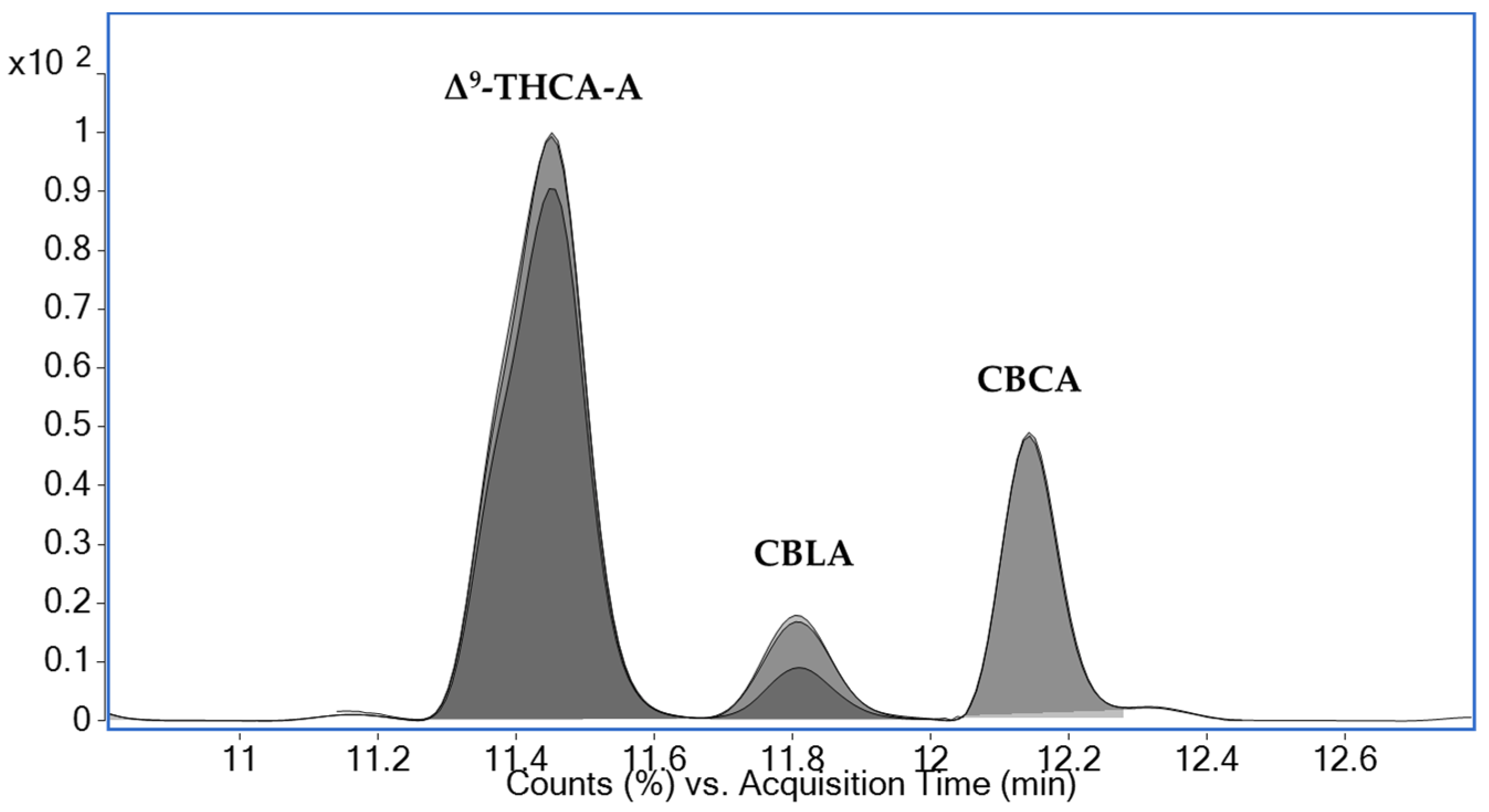
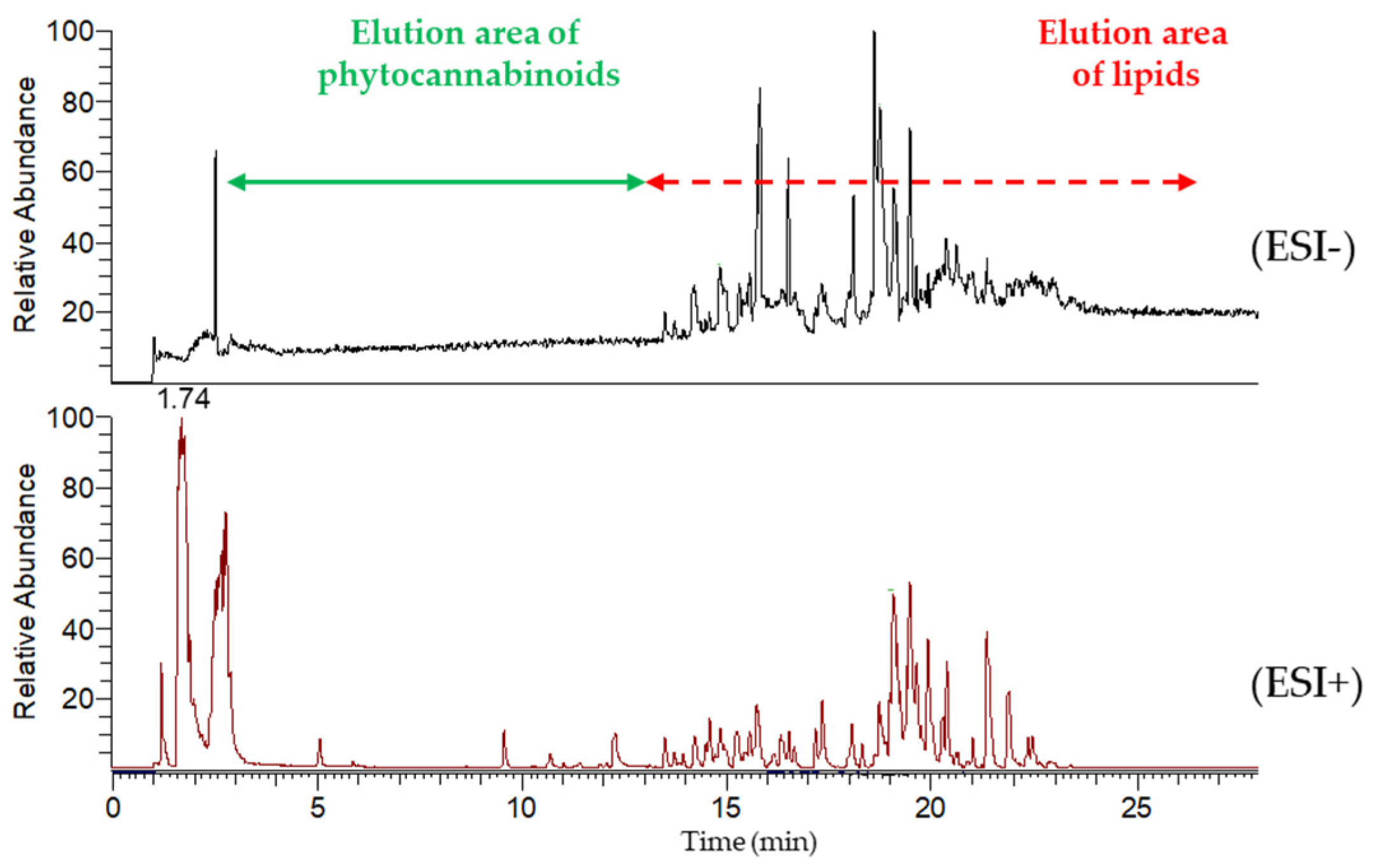

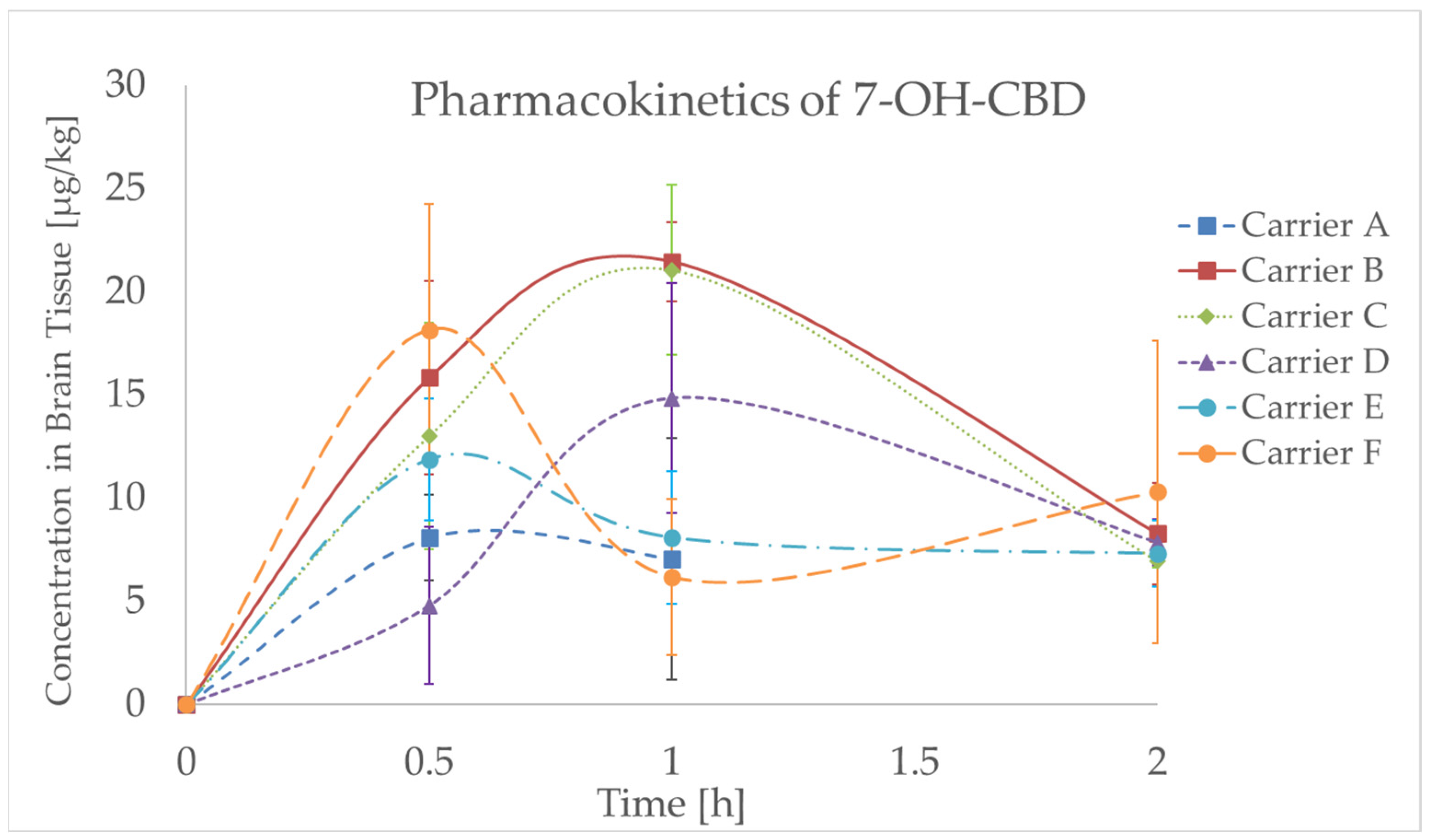
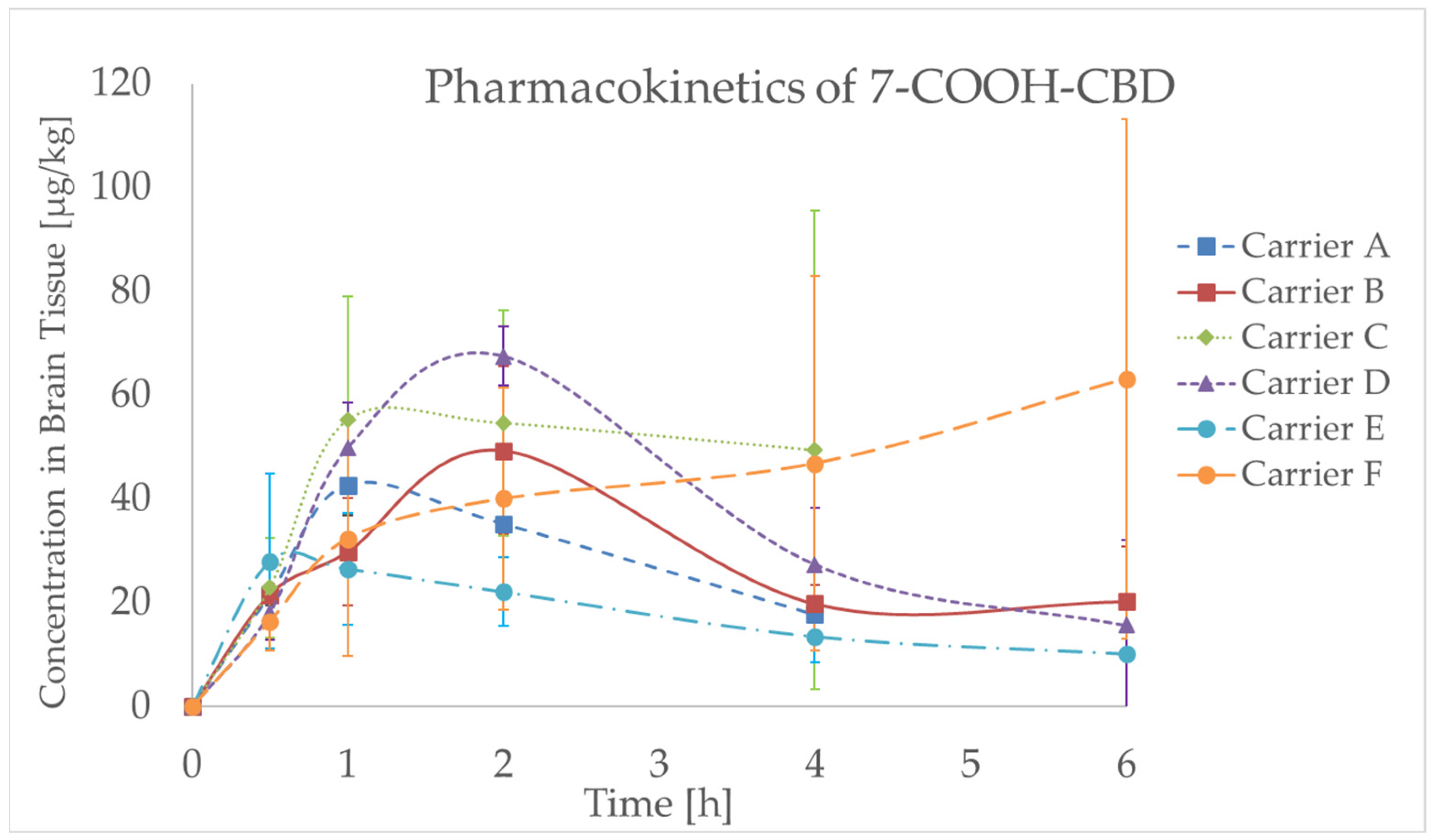
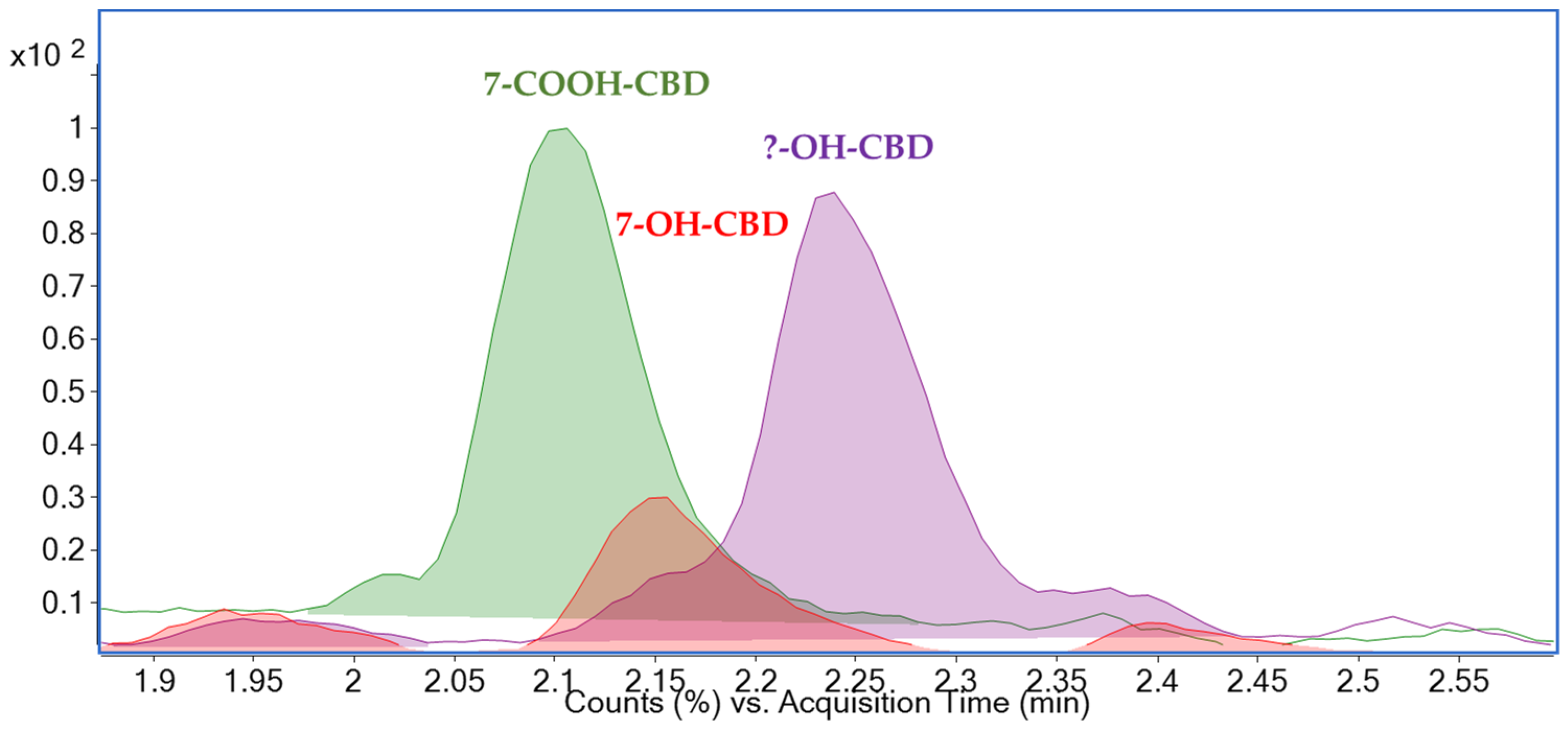
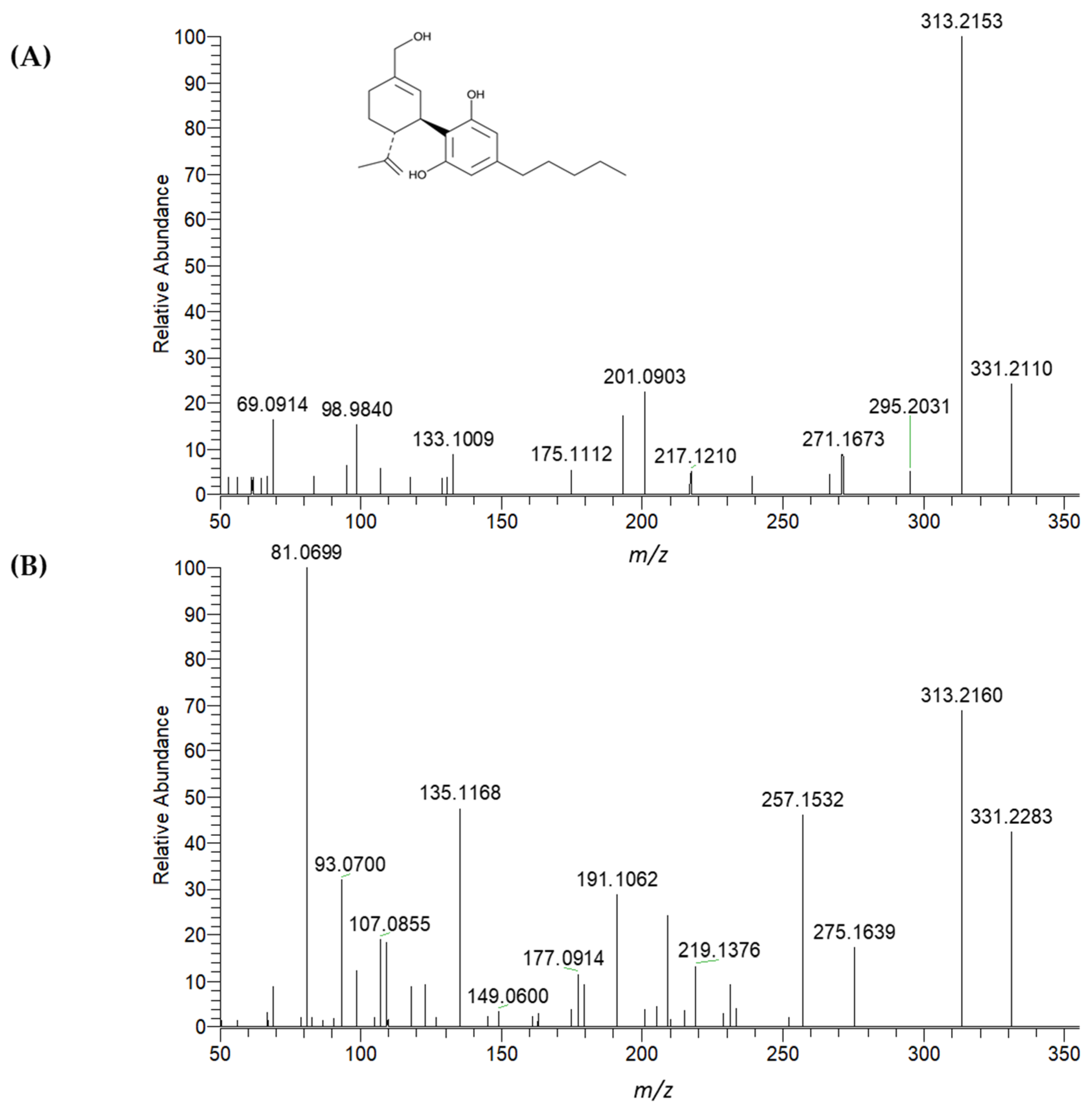
| Time (h) | CBD (µg/kg) | |||||
|---|---|---|---|---|---|---|
| Carrier A 1 | Carrier B | Carrier C 1 | Carrier D | Carrier E | Carrier F | |
| 0.5 | 26 ± 10 | 78 ± 50 | 50 ± 40 | 66 ± 67 | 34 ± 15 | 24 ± 16 |
| 1 | 88 ± 9.2 | 259 ± 150 | 226 ± 118 | 119 ± 43 | 59 ± 33 | 51 ± 15 |
| 2 | 59 ± 11 | 191 ± 40 | 103 ± 73 | 124 ± 45 | 57 ± 22 | 76 ± 52 |
| 4 | 24 ± 14 | 26 ± 15 | 48 ± 38 | 34 ± 11 | 13 ± 6.9 | 29 ± 2.4 |
| 6 | \ | 23 ± 22 | \ | 36 ± 27 | 15 ± 1.5 | 33 ± 26 |
| Time (h) | 7-COOH-CBD (µg/kg) | |||||
| Carrier A 1 | Carrier B | Carrier C 1 | Carrier D | Carrier E | Carrier F | |
| 0.5 | 22 ± 0.03 | 22 ± 5.5 | 23 ± 10 | 18 ± 5.2 | 28 ± 17 | 16 ± 5.7 |
| 1 | 43 ± 6.0 | 30 ± 10 | 55 ± 24 | 50 ± 8.8 | 27 ± 11 | 32 ± 23 |
| 2 | 35 ± 3.2 | 49 ± 16 | 55 ± 22 | 68 ± 5.6 | 22 ± 6.7 | 40 ± 21 |
| 4 | 18 ± 3.5 | 20 ± 3.6 | 49 ± 46 | 27 ± 11 | 14 ± 5.1 | 47 ± 36 |
| 6 | \ | 20 ± 11 | \ | 16 ± 16 | 10 ± 4.1 | 63 ± 50 |
| Time (h) | 7-OH-CBD (µg/kg) | |||||
| Carrier A 1 | Carrier B | Carrier C 1 | Carrier D | Carrier E | Carrier F | |
| 0.5 | 8.1 ± 2.1 | 16 ± 4.7 | 13 ± 5.5 | 4.8 ± 3.8 | 12 ± 3.0 | 18 ± 6.1 |
| 1 | 7.1 ± 5.8 | 22 ± 1.9 | 21 ± 4.1 | 15 ± 5.6 | 8.1 ± 3.2 | 6.2 ± 3.8 |
| 2 | <4 | 8.3 ± 2.5 | 6.9 ± 0.30 | 7.9 ± 1.1 | 7.3 ± 1.6 | 10 ± 7.3 |
| 4 | <4 | <4 | <4 | <4 | <4 | <4 |
| 6 | \ | <4 | \ | <4 | <4 | <4 |
| PK Parameter | CBD | |||||
|---|---|---|---|---|---|---|
| Carrier A 1 | Carrier B | Carrier C 1 | Carrier D | Carrier E | Carrier F | |
| Cmax (µg/kg) | 88 | 259 | 226 | 124 | 59 | 76 |
| Tmax (h) | 1 | 1 | 1 | 2 | 1 | 2 |
| AUC0–6 (µg/kg × h) | 192 | 596 | 397 | 412 | 186 | 255 |
| PK Parameter | 7-COOH-CBD | |||||
| Carrier A 1 | Carrier B | Carrier C 1 | Carrier D | Carrier E | Carrier F | |
| Cmax (µg/kg) | 43 | 30 | 55 | 68 | 27 | 63 |
| Tmax (h) | 1 | 2 | 1 | 2 | 1 | 6 |
| AUC0–6 (µg/kg × h) | 113 | 167 | 184 | 218 | 105 | 250 |
| PK Parameter | 7-OH-CBD | |||||
| Carrier A 1 | Carrier B | Carrier C 1 | Carrier D | Carrier E | Carrier F | |
| Cmax (µg/kg) | 8 | 22 | 21 | 15 | 17 | 18 |
| Tmax (h) | 0.5 | 1 | 1 | 1 | 0.5 | 1 |
| AUC0–6 (µg/kg × h) | 9 | 36 | 36 | 25 | 23 | 31 |
Disclaimer/Publisher’s Note: The statements, opinions and data contained in all publications are solely those of the individual author(s) and contributor(s) and not of MDPI and/or the editor(s). MDPI and/or the editor(s) disclaim responsibility for any injury to people or property resulting from any ideas, methods, instructions or products referred to in the content. |
© 2025 by the authors. Licensee MDPI, Basel, Switzerland. This article is an open access article distributed under the terms and conditions of the Creative Commons Attribution (CC BY) license (https://creativecommons.org/licenses/by/4.0/).
Share and Cite
Binova, Z.; Benes, F.; Zlechovcova, M.; Maly, M.; Kastanek, P.; Cahova, M.; Stranska, M.; Hajslova, J. Pharmacokinetics of Cannabidiol in Rat Brain Tissue After Single-Dose Administration of Different Formulations. Molecules 2025, 30, 2676. https://doi.org/10.3390/molecules30132676
Binova Z, Benes F, Zlechovcova M, Maly M, Kastanek P, Cahova M, Stranska M, Hajslova J. Pharmacokinetics of Cannabidiol in Rat Brain Tissue After Single-Dose Administration of Different Formulations. Molecules. 2025; 30(13):2676. https://doi.org/10.3390/molecules30132676
Chicago/Turabian StyleBinova, Zuzana, Frantisek Benes, Marie Zlechovcova, Matej Maly, Petr Kastanek, Monika Cahova, Milena Stranska, and Jana Hajslova. 2025. "Pharmacokinetics of Cannabidiol in Rat Brain Tissue After Single-Dose Administration of Different Formulations" Molecules 30, no. 13: 2676. https://doi.org/10.3390/molecules30132676
APA StyleBinova, Z., Benes, F., Zlechovcova, M., Maly, M., Kastanek, P., Cahova, M., Stranska, M., & Hajslova, J. (2025). Pharmacokinetics of Cannabidiol in Rat Brain Tissue After Single-Dose Administration of Different Formulations. Molecules, 30(13), 2676. https://doi.org/10.3390/molecules30132676








